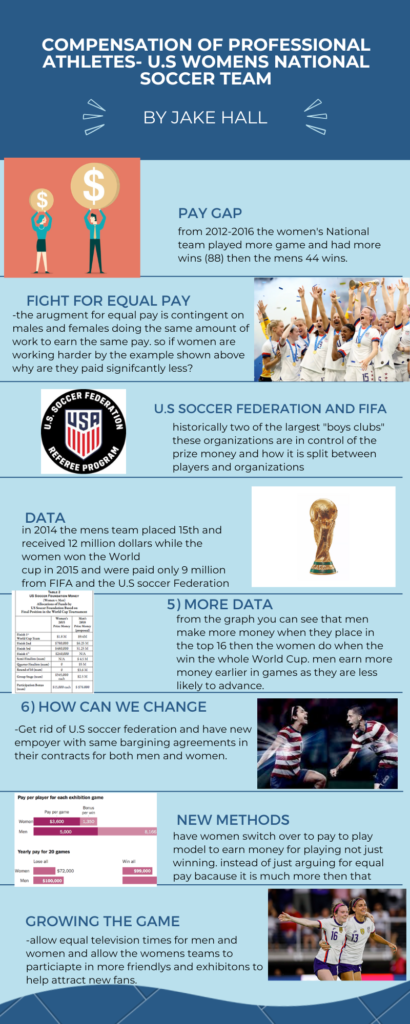In the world of professional sports, the compensation of men and women sports has always been a hot topic of conversation. Male and females aren’t being paid the same wage to perform the same task. With this may seem like a simple concept to understand, it’s a lot deeper than you may expect. Women have been given the short end of the stick. They are often paid less, given worse facilities to use, hotels to stay in, and food to eat. These discrepancies can be shown by the United States Women’s National Soccer Team. They have consistently placed higher in World Cup matches than the men’s national team. For example in 2014, the men’s team placed 15th and received twelve million dollars. In 2014 the women’s national team Won the World Cup and was awarded nine million dollars. This is a very frustrating source to see, especially knowing that both the men’s and women’s teams are employed by the same employer: The United States Soccer foundation. This foundation controls how the winnings are divided and how much money goes to the players. One of the main reasons the women are paid less is due to their contract clauses. The men’s follow a pay to play model where they are awarded money for just playing and additional money for winning. Women are given a year long salary that allows them to miss games and still get paid, but the money is very modest (around $72000 a year, plus $1350 per win). Using this method men will make more even if they lose every game and the females one all theirs. Men are paid more than the women despite playing less games, and the women’s team produces more revenue. One main argument to help encourage equal pay is to pay players based on revenue shares. In 2015 females produced twenty three million dollars in revenue and the men’s produced twenty one million dollars. The issue with this data is the women’s team won the world cup in 2015 and the men’s team placed 16th. This comes from men statistically watching sports more and having more television time and people in the stadiums. While this is an ongoing issue there are many things that can be changed.
One issue that could be changed is to remove the U.S Soccer Federation and have separate employers for both the men’s and women’s national team. If having separate employers is not a feasible option that there needs to be contract negotiations. The women’s team should change their approach from fighting for an “equal pay” model to a “pay to play” model similar to the men’s. Also growing the game. FIFA has been notoriously bad at contributing to growing the game of women’s soccer. The women’s national team needs to have more televisions and social media attention, as well as more friendly and exhibitions to help attract people to the game. While reading about this issue I was shocked to see the inequalities still present in U.S soccer and sports around the world. Without intervention from players or outside help, many of these issues are often ignored and overlooked. That’s why it’s important for players to stand up and fight for what they believe is fair and equal. Having learned this information allows me to better see and understand data that doesn’t relate to me, and to better understand the daily struggles of women in their fights for equal pay and opportunity. Two questions I have from my research is how is the U.S soccer foundation allowed to employ both the men’s and the women’s National team, yet have different bargaining agreements? And do you believe paying based off of revenue shares would benefit or harm the women’s National team.?

Works Cited
Garris, Morgan, and Bill Wilkes. “Soccer Nomics: Salaries for World Cup Soccer Athletes.” Jwpress.com, International Journal of the Academic Business World, https://jwpress.com/Journals/IJABW/BackIssues/IJABW-Fall-2017.pdf.
Jordan, Samantha. “Captain, My Captain: A Look at Autonomous Ships and How They Should Operate under Admiralty Law.” Indiana International & Comparative Law Review, vol. 30, no. 2, 2020, p. 283-318. HeinOnline, https://heinonline.org/HOL/P?h=hein.journals/iicl30&i=338.
Rowan, Jenna N. “Equal Protection for Equal Play: A Constitutional Solution to Gender Discrimination in International Sports.” Vanderbilt Journal of Entertainment & Technology Law, vol. 20, no. 3, Spring 2018, pp. 919-946. HeinOnline, https://heinonline.org/HOL/P?h=hein.journals/vanep20&i=981.
–


